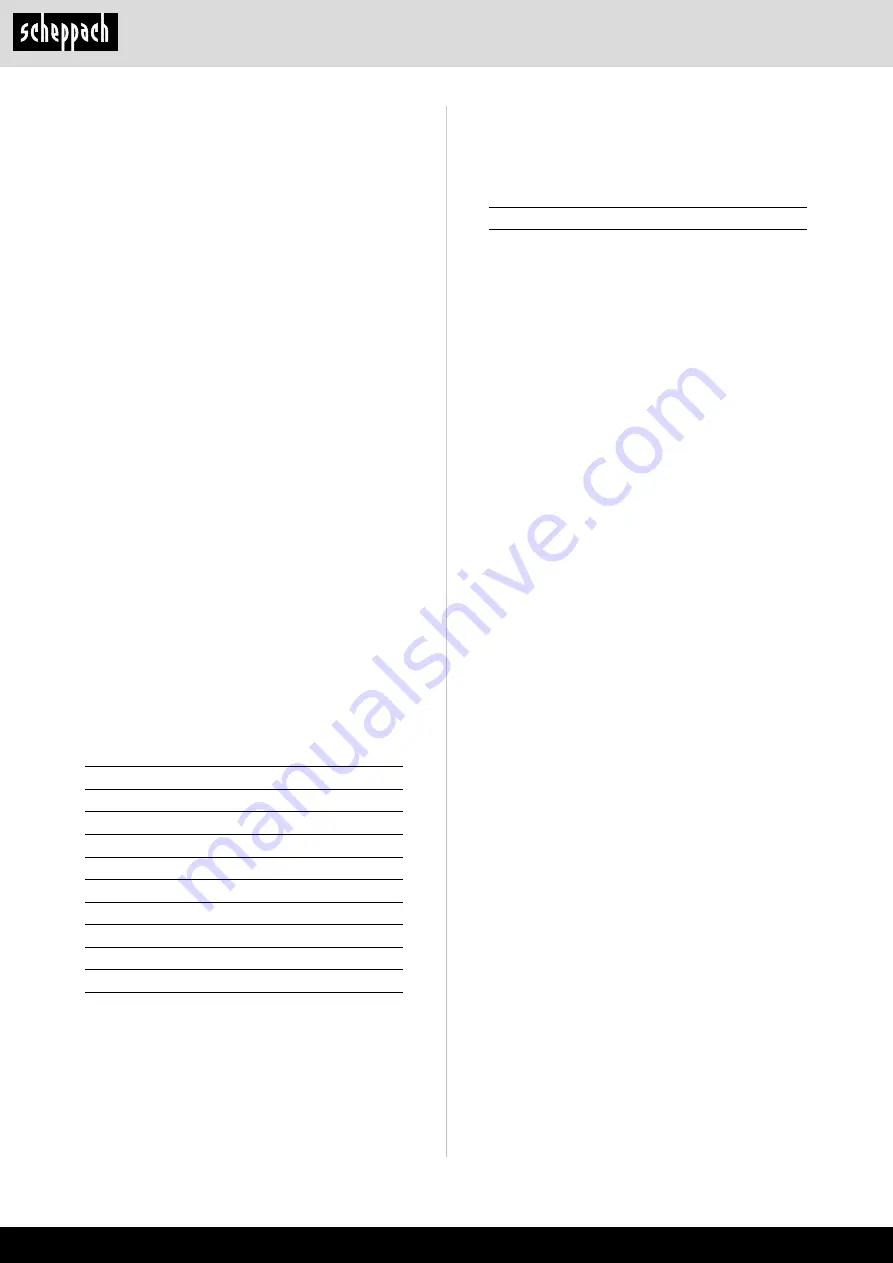
www.scheppach.com /
service@scheppach.com /
+(49)-08223-4002-99 /
+(49)-08223-4002-58
32 | GB
•
The work area must exceed 30 m³ and suffi cient
ventilation must be ensured during spraying and
drying.
• Do not spray against the wind. Always adhere to
the regulations of the local police authority when
spraying combustible or hazardous materials.
• Do not process media such as white spirit, butyl
alcohol and methylene chloride with the PVC pres-
sure hose. These media will destroy the pressure
hose.
• The work area must be separated from the com-
pressor so that it cannot come into direct contact
with the working medium
Operating pressure vessels
• You must keep your pressure vessel in good work-
ing order, operate the vessel correctly, monitor the
vessel, carry out necessary maintenance and re-
pair work immediately and meet the relevant safety
precautions.
• The supervisory authority may enforce essential
control measures in individual cases.
• A pressure vessel is not allowed to be used if it has
faults or deficiencies that can endanger workers or
third parties.
• Check the pressure vessel for signs of rust and
damage each time before using. Do not use the
compressor with a damaged or rusty pressure ves-
sel. If you discover any damage, then please con-
tact the customer service workshop.
Do not lose these safety instructions
6. Technical data
Mains connection
230 V~ 50 Hz
Motor rating
2200 W
Operating mode
S1
Compressor speed
2850 min
-1
Pressure vessel capacity
50 l
Operating pressure
approx. 10 bar
Theoretical intake capacity
approx. 412 l/min
Theoretical delivery rate
approx. 274 l/min
Protection type
IP20
Weight of the unit
approx. 41 kg
Oil (15W 40)
approx. 0,25 l
Max. altitude
(above mean sea level)
1000 m
The noise emission values were measured in accord-
ance with EN ISO 3744.
Wear hearing protection.
The effects of noise can cause a loss of hearing.
m
Warning:
Noise can have serious effects on
your health. If the machine noise exceeds 85 dB (A),
please wear suitable hearing protection.
Sound power level L
wA
97 dB(A)
Sound pressure level L
pA
71 dB(A)
Uncertainty K
wA/pA
2,03 dB(A)
7. Before starting the equipment
• Before you connect the equipment to the mains
supply make sure that the data on the rating plate
are identical to the mains data.
• Prior to initial commissioning, remove the transport
plug and fill the crank housing with oil as described
in item 8.4.
• Check the equipment for damage which may have
occurred in transit. Report any damage immedi-
ately to the transport company which was used to
deliver the compressor.
• Install the compressor near the point of consump-
tion.
• Avoid long air lines and supply lines (extension ca-
bles).
• Make sure that the intake air is dry and dustfree.
• Do not install the compressor in a damp or wet
room.
• The compressor may only be used in suitable
rooms (with good ventilation and an ambient tem-
perature from +5 °C to 40 °C). There must be no
dust, acids, vapors, explosive gases or inflamma
-
ble gases in the room.
• The compressor is designed to be used in dry
rooms. It is prohibited to use the compressor in ar-
eas where work is conducted with sprayed water.
• The oil level in the compressor pump has to be
checked before putting the equipment into opera-
tion.
•
The compressor may only be used outdoor briefly
when the ambient conditions are dry.
• The compressor must always be kept dry and must
not be left outdoors after work is complete.
8. Attachment and operation
m
Important!
You must fully assemble the appliance before using it
for the first time!
You will require the following tools for assembly and
installation:
• 2 x open-ended wrench size 19 mm (not included)
• 2 x open-ended wrench size 14 mm (not included)
8.1 Fitting the wheels (Fig. 5)
• Fit the supplied wheels (11) as shown.









































